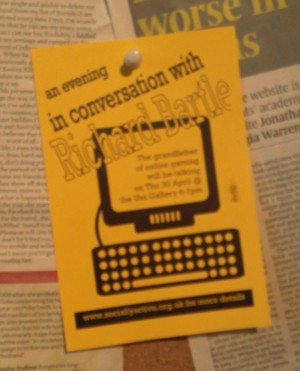And hour later, I wound it up.
OK, so the audience was about a dozen or 15 people strong. They weren't computer gamers (the programming labs had been hit with fliers, but for some reason these put them off:

I can't imagine why — "the grandfather of online gaming" sounds so authoritative...). However, even though these were people who didn't know much about virtual worlds, they did know about art, philosophy and performance. In the course of the discussion, we touched on the magic circle*, the Mulligan/Koster dialectic, shovelware, auteur theory, game criticism (or lack thereof), art-within-art and the semiotics of MMOs.
So this was a group of intelligent non-gamers who had had only what I'd said in my talk and what they'd read in newspapers to go on, but they were nevertheless able to identify a number of key issues to do with virtual worlds in their questions. Of course, they didn't use terms like "magic circle" or "shovelware" — I had to tell them the labels we use — but they picked up on the concepts.
Oh yes, they were asking about game grammars, too.
To me, this shows just how far we have to go in our understanding of virtual worlds. At the moment, it's basically just we designers who are scratching at the surface. We're not trained in this kind of area, we're basically self-taught, and we're not doing it because we find it intrinsically interesting but because we want to use what we discover to inform our creation of better virtual worlds. If virtual worlds were to gain sufficient respectability that mainstream liberal arts academics were to become interested in them, on this evidence they would be able to sweep past what we've taken 30 years to figure out in a single conference.
As it was, I don't know who was more impressed: me with the audience, for so swiftly spotting some of the pressure points in virtual world design; or they with me, for being able to talk art with them despite my being a game designer (something which in part is down to sheer luck: I've discussed these things at great length with a formally-trained artist working within a more traditional medium whom I got to know only because we happen to have the same name).
I do hope I live long enough to see all this happen...
* No, Wikipedia, we don't call them "synthetic worlds". Sorry, Ted...